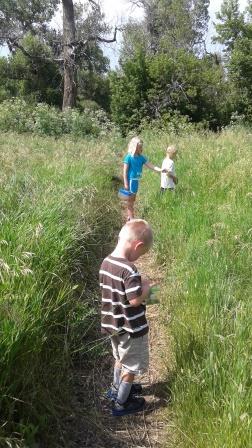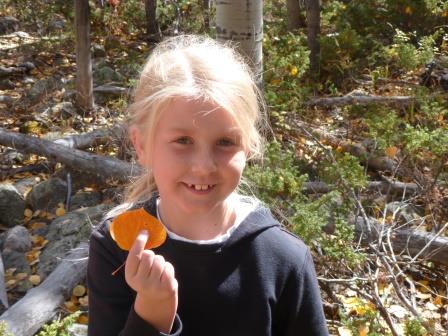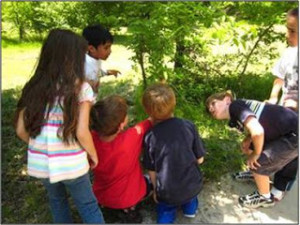 For 10 years, I’ve spent most of my professional life working with teachers on how to use environmental education (EE) resources in the classroom–or wherever they work. When my own children began Vanderhoof Elementary School in Arvada, Colorado, I wanted their teachers to use EE, specifically Project Learning Tree (PLT) activities, in the classroom. My kids will be at this school for 6 years. Teaching one grade level or just a handful of teachers wouldn’t cover it. I wanted to share EE with the whole school, or at least as many teachers as I could reach.
For 10 years, I’ve spent most of my professional life working with teachers on how to use environmental education (EE) resources in the classroom–or wherever they work. When my own children began Vanderhoof Elementary School in Arvada, Colorado, I wanted their teachers to use EE, specifically Project Learning Tree (PLT) activities, in the classroom. My kids will be at this school for 6 years. Teaching one grade level or just a handful of teachers wouldn’t cover it. I wanted to share EE with the whole school, or at least as many teachers as I could reach.
A Question for the Principal
Instead of an open invitation to attend a traditional PLT K-8 workshop, I approached the principal with a simple question, “What is the best way to offer PLT?” He had heard of PLT but had little experience using it. I wanted to include PLT as in-service training, and his buy-in would make it easier for teachers to participate. I knew the school needed science resources, so I stressed PLT’s strength in this area.
Together, the principal and I came up with a plan. I would present a one-hour in-service to the entire teaching staff, the school would purchase the PLT books, and I would act as a PLT coach for the rest of the school year, meeting with each grade level to determine which PLT activities met its teaching needs. Considering a traditional PLT K-8 workshop runs between 6–8 hours and includes supports to teachers afterwards, this new plan didn’t necessarily reinvent the wheel—but it did create an entirely new cart!
“Meet” PLT
All the teachers from K through 6th grade attended the in-service training. I introduced PLT like a rock star! We cruised through the PLT website, hiked the K-8 guidebook, reviewed correlations to academic standards, demonstrated an activity, and watched a PLT YouTube video.
The next step was to set up individual planning sessions with the teachers from each grade. These sessions took place during already scheduled weekly planning meetings so all teachers from a particular grade were present. In preparation, I asked for theEssential Questions and What Students Should Be Able To Do parts of their Science Standards. I identified the top 10 or so PLT activities that I felt would best meet these requirements, with one activity marked as the most appropriate for the upcoming science unit. Each planning session ran about one hour.
In the first planning session, one teacher remarked, “I love how some activities cover more than one subject. We can use these for literacy, too.” Of course, multidisciplinary learning is a PLT benefit. In the hands of motivated teachers, these activities have great potential.
Over the course of each planning session, something became very clear: Teachers have an incredible number of demands on their time. In an effort to bolster their confidence in PLT and lessen the time it takes to try something new, I offered to teach an activity of their choice to each of the classes in the grade. My only stipulation: that I come in sooner rather than later in the school year.
 From Intentions to Action
From Intentions to Action
Two weeks later, I taught Activity 79 (Tree Lifecycle) to the three 3rd grade classes. I had one hour each to lead them through the activity, with the teacher acting as assistant. It was awesome! In evaluation, one teacher said, “It was so helpful to see how you ran the activity. I wasn’t sure how to visualize it.” Another said, “Tree Lifecycle went perfectly with our science unit. It was more insightful than lessons taught in the past.”
The other planning sessions and in-class demonstrations repeated this positive experience. After working with 2nd graders, where I taught Activity 48 (Field, Forest, and Stream), I received thank-you notes from the kids. One boy drew a picture of each plot we visited and wrote, “Thank you for coming to teach about living and non-living things. My favorite part was measuring that tiny plant in the sand pit!”
Several weeks later at an after-school event, a boy came up to me. I recognized him as one of the 3rd graders. With a smile on his face, he started to sing the Lifecycle song I’d taught weeks before. The principal happened to be standing near me, and with a grin said, “That’s pretty impressive.” He meant his compliment for the child, but I think it applies to PLT, too.
Dynamic Times, Dynamic Approaches
In a profession where effort often seems to outweigh reward, being in the mix with the kids and teachers spurred my enthusiasm for EE and its enormous potential for the improvement of young minds. PLT is still the backbone of environmental education. Bending its traditional format to fit the current needs of teachers is an important part of its future success.
One of my favorite remarks from the kids was simple and complete: “Thanks for teaching me about science.” As EE teaches children about the dynamic natural world around them, let’s be as dynamic in our approach to spreading EE into the lives of teachers and children.
 How to Get Started
How to Get Started
- Make an appointment to meet with the school principal.
- Bring PLT guides to your meeting and stress how easy the materials are to use and how well kids respond to the multi-disciplinary learning.
- Teachers need science resources to supplement their classes. Be sure to make this connection.
- Teachers already get together for trainings. Ask the principal to make PLT a teacher in-service training and highlight the professional development hours the PLT program offers.
- If you can, volunteer to model activities in the classroom and offer to be a PLT coach for teachers throughout the school year. You’ll gain respect and support from the teachers, and it is the teachers who ultimately decide if they will use EE in their classrooms.
Become a PLT workshop facilitator and help teach others to use environmental education and PLT! For more information, contact your PLT State Coordinator.
Photos: Kyle Koyle’s children and their classmates explore the outdoors and nature with the help of PLT activities.


